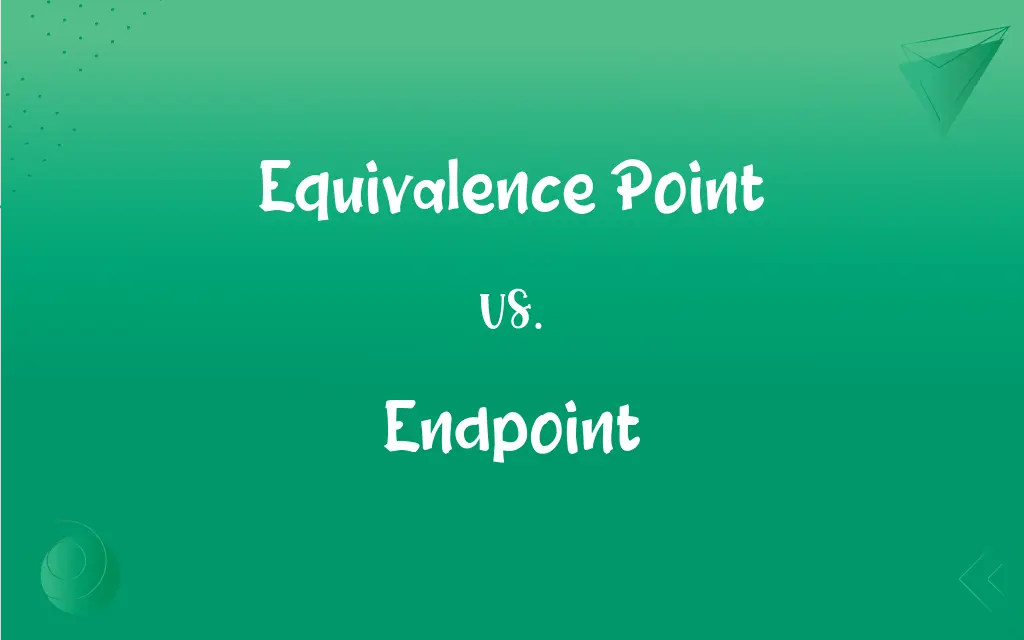Equivalence Point vs. Endpoint: What's the Difference?
Edited by Janet White || By Harlon Moss || Updated on October 20, 2023
Equivalence point is where reactants are stoichiometrically equal; endpoint is where the indicator changes color.

Key Differences
In titration, the equivalence point and the endpoint are often thought of interchangeably, but they have distinct meanings. The equivalence point refers to the exact point where the amount of titrant added stoichiometrically equals the amount of the analyte in the solution. On the other hand, the endpoint is the point where the color of the indicator changes, signaling the end of the titration.
The equivalence point is a theoretical concept, representing the point at which the exact amount of reactant necessary for a complete reaction has been added. The endpoint, conversely, is a practical observation, marked by a visible change in the solution due to an indicator.
Understanding the difference between the equivalence point and the endpoint is vital for accurate titration results. If the endpoint and equivalence point don't coincide, it might lead to a systematic error in the titration, called a titration error. The goal of a successful titration is to make sure the difference between the endpoint and the equivalence point is minimal.
Furthermore, the equivalence point can be identified using various methods, such as pH meters or conductance measurements. The endpoint, however, is solely dependent on the indicator used. Different indicators might have different endpoints for the same titration, making the choice of indicator crucial.
While the equivalence point provides a quantitative measure of the reaction's completion, the endpoint offers a qualitative observation. Both are essential for understanding and interpreting the results of a titration experiment.
ADVERTISEMENT
Comparison Chart
Definition
Theoretical point where reactants are in stoichiometric balance.
Point where an indicator changes color.
Reliance
Stoichiometry of the reaction.
Choice of indicator used.
Identification
PH meters, conductance, etc.
Color change in the solution.
Type
Quantitative measure.
Qualitative observation.
Role in Titration Error
Target point for accurate results.
Can deviate from the equivalence point.
ADVERTISEMENT
Equivalence Point and Endpoint Definitions
Equivalence Point
The point when the amount of titrant equals the amount of analyte.
The equivalence point was reached after adding 25 mL of the solution.
Endpoint
A qualitative measure in titration based on an indicator.
Even though we reached the endpoint, it doesn't always mean the reactants are stoichiometrically equal.
Equivalence Point
A theoretical concept denoting complete reaction.
To determine the concentration, one must know the volume at the equivalence point.
Endpoint
The point determined by the color change of the solution.
Different indicators might show the endpoint at slightly different times.
Equivalence Point
The stoichiometric point in a titration.
A pH meter can be used to precisely determine the equivalence point.
Endpoint
The practical observation marking the end of a titration.
The solution turned pink, indicating we had reached the endpoint.
Equivalence Point
The exact juncture in titration where reactants are balanced.
At the equivalence point, all of the acid had reacted with the base.
Endpoint
The juncture in titration where the indicator changes color.
We concluded the titration once we observed the endpoint's distinct color change.
Equivalence Point
Where the quantity of titrant corresponds to the quantity of the substance being titrated.
The curve's steepest point represents the equivalence point in a pH titration.
Endpoint
The point where the visible sign (usually color) signals titration completion.
It's essential to choose the right indicator to accurately determine the endpoint.
Endpoint
Either of two points marking the end of a line segment.
FAQs
How is the equivalence point different from the endpoint?
The equivalence point is a theoretical concept, while the endpoint is a practical observation based on an indicator's color change.
Is the endpoint always accurate for determining the equivalence point?
Not necessarily. The choice of indicator and its behavior can affect the accuracy of the endpoint relative to the equivalence point.
What is the equivalence point?
It's the exact point in titration where the reactants are stoichiometrically equal.
Can the equivalence point and endpoint be the same?
Ideally, they should be close, but they might not always coincide, leading to titration error.
Why is the equivalence point important in titration?
It provides a quantitative measure of when the reaction is complete.
Is the equivalence point always at the midpoint of a pH titration curve?
Not always. It depends on the strength and nature of the acids and bases involved.
What signifies the endpoint in a titration?
The endpoint is signified by a color change in the solution due to an indicator.
How can one ensure that the endpoint closely matches the equivalence point?
By carefully selecting an appropriate indicator and ensuring accurate titration technique.
What is titration error?
It's the difference between the equivalence point and the observed endpoint.
How does the strength of an acid or base affect the equivalence point?
The strength determines the pH at which the equivalence point occurs in acid-base titrations.
Why might the equivalence point and endpoint not coincide?
Due to the choice of indicator or potential errors in the titration technique.
Why is it essential to differentiate between the equivalence point and endpoint?
Differentiating ensures accurate results and understanding of the titration process.
Are there multiple endpoints in a titration?
A titration can have multiple endpoints if there are multiple equivalence points or if multiple indicators are used.
Can the choice of indicator affect the endpoint?
Yes, different indicators might have different endpoints for the same titration.
What happens if the endpoint is missed during titration?
If the endpoint is missed, it can lead to inaccurate results as the titration might be over or under-titrated.
Can you always visually observe the endpoint?
Usually, yes, if an appropriate indicator is used. However, instrumental methods might also be employed.
Do all titrations have a clear equivalence point?
Most do, but it depends on the reactants involved and the method of detection.
How is the endpoint detected in a colorless titration?
Instrumental methods like pH meters or conductance meters are often used.
Can a titration have multiple equivalence points?
Yes, especially in titrations involving polyprotic acids or bases.
How can you determine the equivalence point without an indicator?
Instruments like pH meters or conductance meters can be used.
About Author
Written by
Harlon MossHarlon is a seasoned quality moderator and accomplished content writer for Difference Wiki. An alumnus of the prestigious University of California, he earned his degree in Computer Science. Leveraging his academic background, Harlon brings a meticulous and informed perspective to his work, ensuring content accuracy and excellence.
Edited by
Janet WhiteJanet White has been an esteemed writer and blogger for Difference Wiki. Holding a Master's degree in Science and Medical Journalism from the prestigious Boston University, she has consistently demonstrated her expertise and passion for her field. When she's not immersed in her work, Janet relishes her time exercising, delving into a good book, and cherishing moments with friends and family.
































































